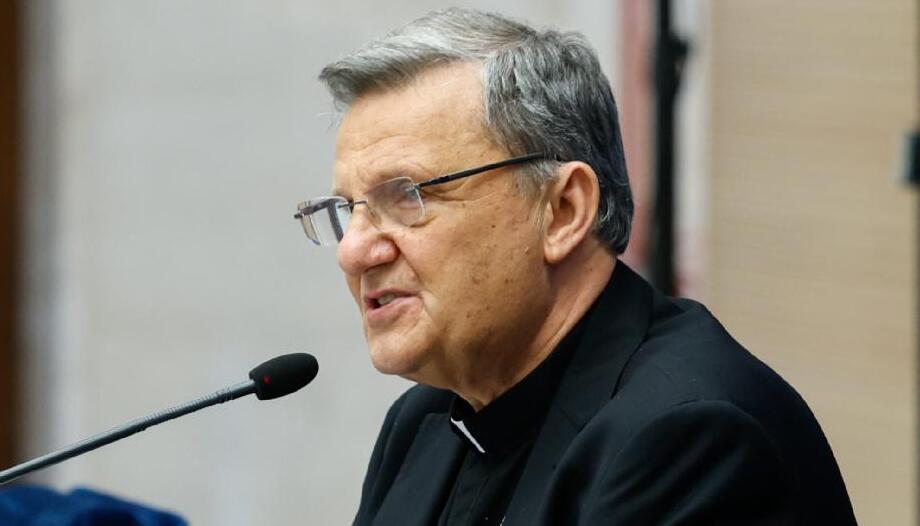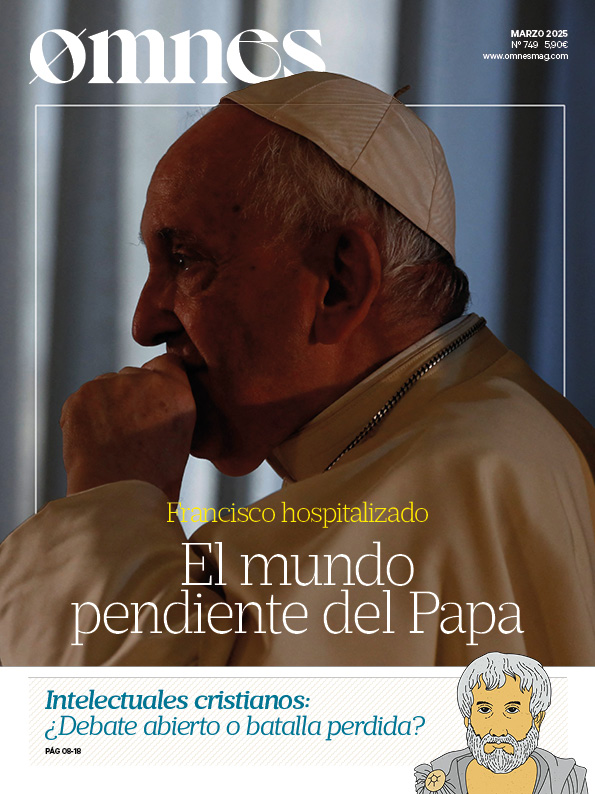The document is 32 pages long and consists of an introduction, foundations, three parts and a conclusion, entitled 'The Synodal Church in the World'. The IL articulates the syntheses received to animate the Assembly's reflection on the central question of October: 'How to be a synodal Church on mission'.
In the conclusion, the text appeals to the encyclical Fratelli tuttiwhich "presents us with the call to recognize ourselves as sisters and brothers in the risen Christ, proposing him not as a status, but as a way of life. The Encyclical underlines the contrast between the times in which we live and the vision of living together prepared by God. The veil, the blanket and the tears of our time are the result of the growing isolation from one another, the increasing violence and polarization of our world and the uprooting of the sources of life".
Synodal missionary Church: deep listening and dialogue
"This Instrumentum laboris," explains the General Secretariat of the Synod, whose titular is Cardinal Mario Grech, "questions and interrogates us on how to be a missionary synodal Church; how to engage in deep listening and dialogue; how to be co-responsible in light of the dynamism of our personal and communal baptismal vocation; how to transform structures and processes so that all can participate and share the charisms that the Spirit pours out on each one for the common good; how to exercise power and authority as service."
"Each of these questions is a service to the Church and, through her action, to the possibility of healing the deepest wounds of our time," the final part of the document adds.
The 'Instrumentum laboris' can be found in several languages on the official website of the General Secretariat of the Synodwhich contains a specific section for the work of the Second Session of the XVI Assembly. In addition to the IL, this section contains Frequently Asked Questions (FAQ), Infographics and other useful documents not only for the preparation of the members of the assembly, but also for any other person or group wishing to deepen their knowledge of the Synodal Church.
In February of this year, Pope Francis ordered that a few study groups analyze ten issuesand will present their conclusions, if possible, before June 2025. One of the questions and answers in this outline, to clarify doubts, refers to this issue.
Questions and answers
The General Secretariat of the Synod has prepared some questions, ten to be precise, with their answers, which Omnes is transmitting here.
What is the 'Instrumentum laboris'?
- As its Latin expression indicates, the 'Instrumentun Laboris' (IL) is first and foremost a working instrument for the members of the Second Session of the XVI Ordinary General Assembly of the Synod of Bishops. This also justifies its language and the use of theological notions and categories in some of its parts. A theological aid, soon to be published, will facilitate its reading and will allow for a deeper study of the theological notions and categories used.
It is born from the reflections that the Episcopal Conferences, the Eastern Catholic Churches and other international ecclesial realities, as well as the reports presented by the pastors during the three-day working meeting of the Pastors for the Synod, have made around the Synthesis Report of the First Session (October 4-29, 2023) in light of the indications given by the General Secretariat of the Synod through the document Towards October 2024.
The IL thus articulates the syntheses received in order to encourage the Assembly's reflection on the central issue of the october assembly How to be a synodal Church in mission.
As a working instrument of the XVI Assembly, the IL is not a magisterial document, nor a catechism. Neither is it a text that offers prefabricated answers, nor a document that pretends to address all the questions related to the need to be more and more "synodal in mission".
It is a document, fruit of listening, discernment and reflection on the synodality that has matured in the course of the synodal process. It is a basic text, articulated but essential, conceived above all as a support for the method with which the assembly will be called to work and to encourage prayer, dialogue, discernment, the maturation of a consensus starting from some convergences matured along the way in view of the delivery to the Holy Father of a Final Document of the XVI Assembly.
The 'Instrumentum laboris' has its origin in the reports received by the General Secretariat of the Synod. Who sent these reports?
- In December 2023, the General Secretariat, through the document 'Towards October 2024', invited the entire Christian community to reflect on the guiding question indicated for the Second Session of the XVI Assembly: How to be a Synodal Church in Mission, proposing a series of differentiated paths and activities based on the Synthesis Report, approved by the members of the XVI Assembly at the end of the work of the First Session, in October 2023.
The aim was to keep the synodal dynamism alive by promoting at the local level a reflection on how to strengthen the differentiated co-responsibility in the mission on the part of all the faithful and, at the same time, to ask the Episcopal Conferences, the Eastern Catholic Churches and the groupings of Churches to reflect on how to articulate the dimension of the Church as a whole and its rootedness at the local level, thus gathering the fruits of the reflection around the Synthesis Report.
Despite the short time available, by June 30, 2024, no less than 108 reports had been received from the Episcopal Conferences (out of 114), 9 from the Eastern Catholic Churches (out of 14), in addition to the contribution of the USG-UISG (respectively, the International Union of Major Superiors and the International Union of Superiors General). In addition to the contribution of some dicasteries of the Roman Curia, the General Secretariat also received more than 200 comments from international entities, university faculties, associations of the faithful or communities and individuals.
Obviously, in drafting the Instrumentum laboris, the General Secretariat also took into account the reports presented by the pastors during the three-day working session of the International Meeting of Pastors for the Synod, as well as those of some working groups: the five groups created by the General Secretariat of the Synod to deepen the theological study of five areas of reflection, in the wake of what was repeatedly requested by the Assembly (the face of the missionary synodal Church; the missionary synodal face of the groupings of Churches; the face of the universal Church; the synodal method; the "place" of the synodal Church in the mission), and a specific commission of canonical experts created to support the work of the theologians.
In this sense, the Instrumentum Laboris can truly be considered a Church document that has been able to dialogue with diverse sensibilities and different pastoral fields.
Who drafted the 'Instrumentum laboris'?
- Like any other document of the General Secretariat of the Synod concerning the synodal process, the Instrumentum Laboris (IL) is the fruit of a work in which a large number of people from various parts of the world and with different competencies have participated.
First of all, a group of theologians (men and women, bishops, priests, consecrated men and women and lay people) from different continents, but also the members of the XV Ordinary Council of the General Secretariat of the Synod accompanied by some Consultors of the same Secretariat.
A first version of the document was then sent to some seventy people, representatives of all the People of God (priests, consecrated men and women, lay people, representatives of ecclesial realities, theologians, pastoral agents and a significant number of pastors) from all over the world, from different ecclesial sensibilities and from different theological "schools".
This broad consultation was carried out in order to maintain consistency with the principle of circularity (what comes from the base, goes back to the base) that animated the entire synodal process. This verification of the material prepared in the light of the reports received was also an exercise, on the part of the General Secretariat, of that accountability that characterizes the synodal Church.
Finally, after due modifications, the IL returned to the hands of the Ordinary Council which, after a series of amendments, approved it and transmitted it to the Holy Father for final approval.
How is it structured?
- The Instrumentum Laboris consists of five sections. After the introduction, the IL opens with a section dedicated to the Fundamentals of the understanding of synodality, which re-proposes the awareness matured along the way and sanctioned by the First Session.
There follow three intimately intertwined parts, which illuminate the missionary synodal life of the Church from different perspectives: (I) the perspective of Relationships - with the Lord, among brethren and among Churches - which sustain the vitality of the Church much more radically than its structures; (II) the perspective of Pathways which concretely sustain and nourish the dynamism of relationships; (III) the perspective of Places which, against the temptation of an abstract universalism, speak of the concreteness of the contexts in which relationships are incarnated, with their variety, plurality and interconnectedness, and with their rootedness in the nascent foundation of the profession of faith.
Each of these Sections will be the subject of prayer, sharing and discernment in one of the modules that will mark the work of the Second Session. A summary of the IL is available at www.synod.va
This 'Instrumentum laboris' seems, in its structure, somewhat different from the previous one, which contained many sheets with many questions, why was this structure chosen?
- The Assembly is an evolving reality and the Instrumentum Laboris is at the service of the Assembly and not the other way around. If in the First Session it was necessary to bring about convergences in the face of the many questions that arose from the broad consultation of the People of God at the local, national and continental levels, now it is necessary that from these convergences it be possible to arrive at a consensus. Whereas in the First Session the members were asked to choose the thematic area in which they wished to make their contribution, in the Second Session all members will address the same text and discuss the same proposals.
The 'Instrumentum Laboris' is for the members of the XVI Assembly, but how can local synodal groups and, in general, the faithful who will not participate in the October Assembly use it? How can they contribute to the work in October?
- The 'Instrumentum laboris' is addressed primarily to the members of the Second Session of the XVI General Assembly of the Synod of Bishops. However, it is also a valuable tool for individual groups at diocesan and national levels who wish to continue their journey of reflection and discernment on how to journey together as Church; and to carry out ecclesial initiatives. For example, the IL can offer a special opportunity for an encounter - even virtual - between members of the Assembly and at least the national team in the preparation phase of the October meeting, also through the synodal method of Conversation in the Spirit.
In this way, the representative role of each of the members of the Assembly can become tangible. In any case, it is important that those who are interested in the synodal conversion of the Church in view of the mission continue their commitment so that the ecclesial dynamism initiated with the consultation of the People of God in 2021 does not fade away and that the exercise of co-responsibility in the mission of the Church continues to develop at the local level, as it is already doing.
In addition, the IL will certainly help to understand how important it is for the faithful to accompany the work of the Assembly with prayer, asking the Holy Spirit - the true protagonist of the work of October - to sustain the great task entrusted to the members of the Assembly.
The 'Instrumentum Laboris' mentions a theological subsidy. What is it?
- To accompany the relatively concise Instrumentum laboris, the General Secretariat of the Synod considered it appropriate to offer some theological and canonical insights on the themes contained in the IL, in order to help the members of the Assembly - without excluding a wider circle of recipients - to recognize and understand the roots and implications of what is contained in the IL.
"Deepening" from a theological point of view means: underlining the reference of individual themes to Sacred Scripture, to the Tradition of the Church, to the Second Vatican Ecumenical Council, to the recent Magisterium of the Bishop of Rome of the world episcopates.
"Deepening" from the canonical point of view means: to show how discernment regarding individual issues can be translated into regulated and verified practices also through the normative instrument.
Rather than an organic text, the Grant will be presented as a series of "glosses" to the IL. In fact, an updated version of the IL will contain some references to the Grant in the margins of individual chapters.
Some topics have been entrusted to the 10 working groups created by Pope Francis. How should this decision be interpreted? Is it a way of eliminating these topics from the Assembly debate?
- From the beginning, Pope Francis insisted that this Synod is not about this or that topic, but about synodality, about how to be a missionary Church on the way. The October Assembly and all the theological questions and pastoral proposals for modification have this purpose. The Assembly should therefore be a time in which each participant, placing himself on a journey that began in 2021 and bringing the "voice" of the people of God from which he comes, invokes the help of the Holy Spirit and that of his brothers and sisters to discern God's will for his Church, and not an opportunity to impose his own vision of the Church.
At the same time, Pope Francis welcomed the convergence that the members of the Assembly had expressed during the First Session around a number of relevant issues concerning the life and mission of the Church in synodal perspective, on which the Assembly had reached a consistent consensus, almost always higher than 90%, through the creation of 10 specific working groups. These are important issues, some of which require to be dealt with at the level of the whole Church and in collaboration with the Dicasteries of the Roman Curia.
It is not, therefore, a matter of subtracting certain questions from the debate of the assembly, which has already expressed a convergence as to their importance, but of providing useful elements from the theological and canonistic point of view to offer to Peter's ministry.
Therefore, these groups should already be considered a fruit of the synodal journey. Experts and bishops from different parts of the world are participating in these groups, identified on the basis of their experience and respecting the variety of geographical origins, disciplinary backgrounds, gender and ecclesial status necessary for an authentically synodal approach.
They are collecting and enriching existing contributions on the topics assigned to them. The Groups should conclude their work, if possible, before the end of June 2025.
What can we expect at the conclusion of the Synod?
- The celebration of the Second Session of the XVI Assembly of the Synod of Bishops will not mean the end of the synodal process. The Apostolic Constitution Episcopalis Communio (EP), which governs the entire synodal process, recalls that the synod consists essentially of three phases: consultation of the faithful, discernment by the pastors and the implementation phase.
These three phases should not be understood only in a chronological sense. In fact, with the celebration of the XVI Assembly, according to the EP, we would be in the phase of discernment of the pastors, which would be followed by the moment of reception of the work of the Assembly by the local communities.
However, the discernment of pastors accompanied almost the entire synodal process (i.e., already in the consultation phase, which in fact already saw the discernment of pastors at the local, national and continental levels).
Moreover, we can testify that the "implementation" phase has already begun immediately after the first meetings. The synodal "fruits" are already numerous: many are the testimonies of those ecclesial realities that have changed their ecclesial actions in a synodal sense with a greater co-responsibility of all the baptized faithful.
Therefore, the conclusion of the Second Session will not be the end of the synodal process, but only an important moment in the discernment of the pastors.
On the other hand, in previous synods a final document was approved and delivered to the Holy Father. This document contained some indications that the Assembly wished to give to the Pope. Normally, after a few months, the Pope would deliver to the whole Church a document called the Post-Synodal Exhortation, which contained some provisions related to the topic in question.
It is expected that this Assembly will also produce a final document to be submitted to the Holy Father for a possible exhortation. The purpose of the Synodal Assembly is to offer guidance to the Pope. The Synod is consultative and not deliberative.
Where can IL be found?
- The 'Instrumentum laboris' can be found in several languages on the official website of the General Secretariat of the Synod (www.synod.va), where a specific section has been created for the work of the Second Session of the XVI Assembly. In addition to the IL, this section also contains Frequently Asked Questions (FAQ), Infographics and other useful documents not only for the preparation of the members of the assembly, but also for any other person or group wishing to deepen their knowledge of the synodal Church.








